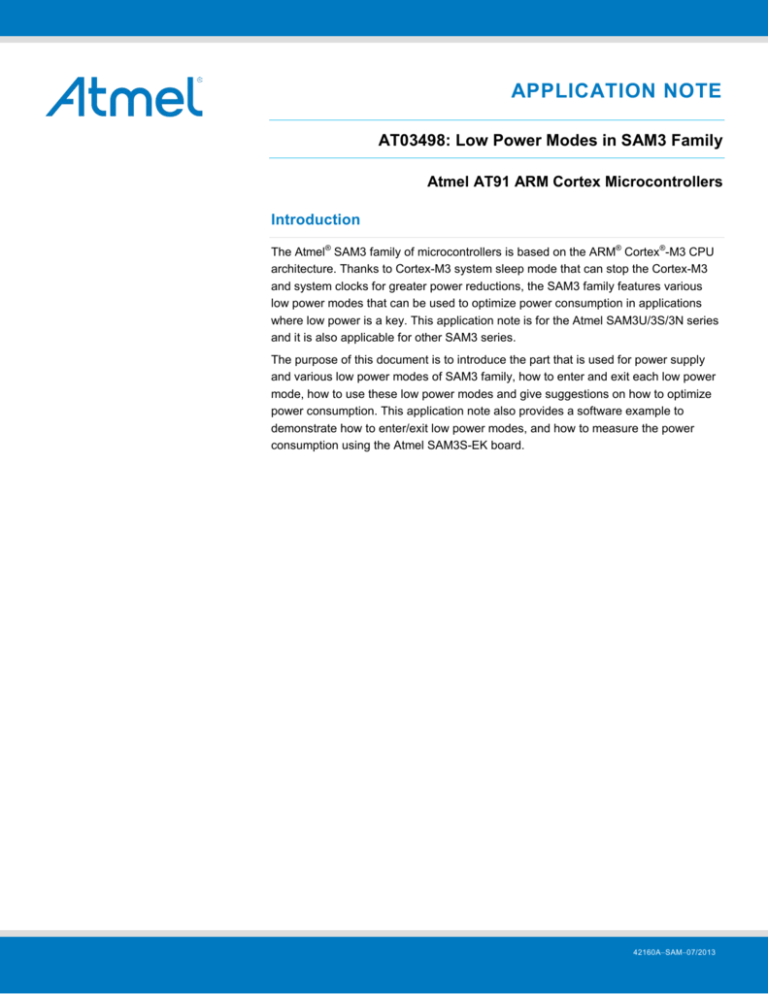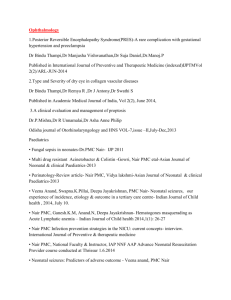
APPLICATION NOTE
AT03498: Low Power Modes in SAM3 Family
Atmel AT91 ARM Cortex Microcontrollers
Introduction
The Atmel® SAM3 family of microcontrollers is based on the ARM® Cortex®-M3 CPU
architecture. Thanks to Cortex-M3 system sleep mode that can stop the Cortex-M3
and system clocks for greater power reductions, the SAM3 family features various
low power modes that can be used to optimize power consumption in applications
where low power is a key. This application note is for the Atmel SAM3U/3S/3N series
and it is also applicable for other SAM3 series.
The purpose of this document is to introduce the part that is used for power supply
and various low power modes of SAM3 family, how to enter and exit each low power
mode, how to use these low power modes and give suggestions on how to optimize
power consumption. This application note also provides a software example to
demonstrate how to enter/exit low power modes, and how to measure the power
consumption using the Atmel SAM3S-EK board.
42160A−SAM−07/2013
Table of Contents
1. Power Supply ..................................................................................... 3
1.1
1.2
1.3
1.4
1.5
1.6
1.7
1.8
1.9
1.10
Power Supply of SAM3U ................................................................................... 3
Power Supply of SAM3S ................................................................................... 4
Power Supply of SAM3N ................................................................................... 5
Supply Controller (SUPC) ................................................................................. 6
Voltage Regulator ............................................................................................. 6
Supply Monitor .................................................................................................. 6
Brown-out Detector (BOD) ................................................................................ 6
General Purpose Backup Registers (GPBR) .................................................... 6
Power Management Controller (PMC) .............................................................. 6
Typical Powering Schematics ........................................................................... 7
2. Various Power Modes ........................................................................ 7
2.1
2.2
2.3
2.4
2.5
Active Mode ...................................................................................................... 7
Sleep Mode ....................................................................................................... 7
2.2.1
Enter the Sleep Mode ......................................................................... 8
2.2.2
Exit the Sleep Mode ............................................................................ 8
Wait Mode ......................................................................................................... 8
2.3.1
Enter the Wait Mode ........................................................................... 8
2.3.2
Exit the Wait Mode ............................................................................ 10
Backup Mode .................................................................................................. 10
2.4.1
Enter the Backup Mode .................................................................... 10
2.4.2
Exit the Backup Mode ....................................................................... 10
Low Power Mode Summary ............................................................................ 11
3. Using Low Power Modes.................................................................. 12
3.1
3.2
3.3
3.4
Optimizing Power Consumption ...................................................................... 12
Sleep Mode vs. Polling Loops ......................................................................... 13
Sleep Mode vs. Wait Mode ............................................................................. 13
Using Backup Mode ........................................................................................ 14
4. Low Power Example ........................................................................ 15
4.1
4.2
Hardware Setup .............................................................................................. 15
Running the Example ...................................................................................... 15
5. References ...................................................................................... 15
6. Revision History ............................................................................... 16
AT03498: Low Power Modes in SAM3 Family [APPLICATION NOTE]
42160A−SAM−07/2013
2
1.
Power Supply
1.1
Power Supply of SAM3U
Figure 1-1 gives an overview of the Supply Controller of the Atmel SAM3U.
Figure 1-1. Supply Controller of SAM3U.
The SAM3U product has several types of power supply pins:
VDDCORE:
Powers the core, the embedded memories and the peripherals
VDDIO:
Powers the peripherals I/O lines
VDDIN:
Powers the voltage regulator
VDDOUT:
It is the output of the voltage regulator; Intended to supply the core of the device
VDDBU:
Powers the Slow Clock oscillator and a part of Controller
VDDPLL:
Powers the PLL A, UPLL and 3MHz to 20MHz oscillator
AT03498: Low Power Modes in SAM3 Family [APPLICATION NOTE]
42160A−SAM−07/2013
3
VDDUTMI:
Powers the USB UTMI + interface
VDDANA:
Powers the ADC cells
The device can be divided into two power supply areas: Backup Power Supply and Core Power Supply.
1.2
Power Supply of SAM3S
Figure 1-2 gives an overview of the Supply Controller of the Atmel SAM3S.
Figure 1-2. Supply Controller of SAM3S.
There are several types of power supply pins:
VDDCORE:
Powers the core, the embedded memories and the peripherals
VDDIO:
Powers the peripherals I/O lines (Input/Output Buffers); USB transceiver; Backup part, 32kHz crystal
oscillator and oscillator pads
VDDIN:
Voltage Regulator Input, ADC, DAC and Analog Comparator Power Supply
VDDOUT:
It is the output of the voltage regulator; Intended to supply the core of the device
VDDPLL:
Powers the PLLA, PLLB, the Fast RC and the 3MHz to 20MHz oscillator
The device can be divided into two power supply areas: Backup Power Supply and Core Power Supply.
AT03498: Low Power Modes in SAM3 Family [APPLICATION NOTE]
42160A−SAM−07/2013
4
1.3
Power Supply of SAM3N
Figure 1-3 gives an overview of the Supply Controller of the Atmel SAM3N.
Figure 1-3. Supply Controller of SAM3N.
There are several types of power supply pins:
VDDCORE:
Powers the core, the embedded memories and the peripherals
VDDIO:
Powers the peripherals I/O lines (Input/Output Buffers); USB transceiver; Backup part, 32kHz crystal
oscillator and oscillator pads
VDDIN:
Voltage Regulator Input, ADC, DAC and Analog Comparator Power Supply
VDDOUT:
It is the output of the voltage regulator; Intended to supply the core of the device
VDDPLL:
Powers the PLL, the Fast RC and the 3MHz to 20MHz oscillator
The device can be divided into two power supply areas: Backup Power Supply and Core Power Supply.
AT03498: Low Power Modes in SAM3 Family [APPLICATION NOTE]
42160A−SAM−07/2013
5
1.4
Supply Controller (SUPC)
The Supply Controller controls the supply voltage of the Core of the system and manages the Backup mode by
controlling the Embedded Voltage Regulator.
The Supply Controller starts up the device by enabling the voltage regulator. Then it generates the proper reset signals
to the core power supply.
It also enables to set the system in different low power modes and to wake it up from a wide range of events.
1.5
Voltage Regulator
The voltage regulator is managed by the Supply Controller. This internal regulator is intended to supply the core of the
device but can be used to supply other parts in the application. It features two different operating modes:
•
In Normal mode, the voltage regulator supplies power to core domain, internal adaptive biasing automatically
adjusts the regulator quiescent current depending on the required load current. In Wait mode quiescent current
is only 7µA
•
In Shutdown mode, the voltage regulator is disabled and its output is driven internally to GND, it consumes
less than 1μA. When system enters Backup mode, the SUPC disable voltage regulator automatically
In addition, when the user does not use the internal voltage regulator and wants to supply VDDCORE by an external
supply, it is possible to disable the voltage regulator.
1.6
Supply Monitor
The supply monitor can be used to prevent the processor from falling into an unpredictable state if the Main power
supply drops below a certain level. For the Atmel SAM3U series, it monitors VDDUTMI power supply, for SAM3S/3N
series, it monitors VDDIO power supply.
The threshold of the supply monitor is programmable. It can be selected from 1.9V to 3.4V by steps of 100mV. This
threshold is programmed in the SMTH field of the Supply Controller Supply Monitor Mode Register (SUPC_SMMR).
To reduce power consumption, Supply Monitor can be disabled by writing the SMSMPL field to 0 in SUPC_SMMR.
1.7
Brown-out Detector (BOD)
Brown-out detector monitors on VDDCORE. By default, it is enabled.
To reduce power consumption, Brown-out detector can be disabled by writing the BODDIS bit to 1 in SUPC_MR.
1.8
General Purpose Backup Registers (GPBR)
The device embeds four 32-bit general-purpose backup registers which can store 16 bytes of user application data.
When system enter Backup mode, the voltage regulator is disabled, and VDDCORE is off but the backup registers
remain powered by VDDIO (on Atmel SAM3S/3N) or VDDBU (on Atmel SAM3U).They retain the content when the
system wakes up from Backup mode.
1.9
Power Management Controller (PMC)
The Power Management Controller (PMC) controls all system and peripheral clocks. It acts important role for optimizing
power consumption.
AT03498: Low Power Modes in SAM3 Family [APPLICATION NOTE]
42160A−SAM−07/2013
6
1.10
Typical Powering Schematics
There are three typical powering schematics for the system:
•
Single Supply:
•
Core Externally Supplied: The system is power by main supply while the VDDCORE and VDDPLL are
powered by core supply
•
Backup Batteries Used:
The system is powered by single main supply. The internal regulator input
connected to the main supply and its output feeds VDDCORE and VDDPLL
The system is powered by main supply while the backup power supply part is
powered by batteries
For further information, you can refer to Chapter “Power Considerations” of relevant device datasheet.
2.
Various Power Modes
The Atmel SAM3 family of microcontrollers has various power modes, include Active mode and different low power
modes (Sleep, Wait and Backup). Various power modes are shown in Figure 2-1. Each low power mode can be entered
from Active mode and wake up by related enabled wake-up event. The various low power modes are described below.
Figure 2-1. SAM3 Various Power Modes.
2.1
Active Mode
Active mode is the normal running mode. By default, the microcontroller is in Active mode after power on. Following
means can reduce power consumption in Active mode:
•
•
Slow down the system clock
Disable the peripheral clocks when they are unused
The power management controller (PMC) can be used to adapt the frequency and to disable the peripheral clocks.
2.2
Sleep Mode
In Sleep mode, the execution of instructions is suspended because the core clock is stopped while the peripheral clocks
can be enabled. The purpose of sleep mode is to optimize power consumption of the device versus response time. The
core needs lowest wakeup time in this mode.
AT03498: Low Power Modes in SAM3 Family [APPLICATION NOTE]
42160A−SAM−07/2013
7
2.2.1
Enter the Sleep Mode
Sleep mode is entered via Wait for Interrupt (WFI) or Wait for Event (WFE) instructions with LPM = 0 in PMC_FSMR.
This mode is achieved by disabling the core clock by PMC. Following code snippet shows how to enter Sleep mode:
/**
* \brief Enter Sleep Mode.
* Enter condition: (WFE or WFI) + (SLEEPDEEP bit = 0) + (LPM bit = 0)
*
* \param type 0 - wait for interrupt, 1 - wait for event.
*/
void EnterSleepMode(uint8_t type)
{
PMC->PMC_FSMR &= (uint32_t)~PMC_FSMR_LPM;
SCB->SCR &= (uint32_t)~SCR_SLEEPDEEP;
if (type == 0) {
__WFI();
} else {
__WFE();
}
}
When Sleep mode is entered, the current instruction is finished before the clock is stopped, but this does not prevent
data transfers from other masters of the system bus.
2.2.2
Exit the Sleep Mode
Sleep mode is exited from an interrupt if WFI instruction of the Cortex-M3 is used, or from an event if the WFE
instruction is used to enter this mode, or by the reset of the device. The PMC automatically re-enables the processor
clock (PCK) and the core executes the next instruction of the program counter.
2.3
Wait Mode
The purpose of the wait mode is to achieve very low power consumption while maintaining the whole device in a
powered state for a startup time of less than 10μs. In this mode, the clocks of the core, peripherals and memories are
stopped. However, the core, peripherals and memories power supplies are still powered.
2.3.1
Enter the Wait Mode
Wait mode is entered via Wait for Event (WFE) instructions with LPM = 1 (Low Power Mode bit in PMC_FSMR). The Fast
RC Oscillator is disabled by the PMC automatically when entering Wait mode. The step of entering Wait mode as below:
•
•
•
Note:
Select the 4/8/12 MHz Fast RC Oscillator as Main Clock
Set the LPM bit in the PMC Fast Startup Mode Register (PMC_FSMR)
Execute the Wait-For-Event (WFE) instruction of the processor
Internal Main clock resynchronization cycles are necessary between the writing of MOSCRCEN bit and the effective
entry in Wait mode. Depending on the user application, waiting for MOSCRCEN bit to be cleared is recommended
to ensure that the core will not execute undesired instructions.
In most application, the external XTAL oscillator is used instead of on-chip RC oscillator for accurate clock. Following
code snippet shows how to switch MCK from external XTAL oscillator to Fast RC oscillator:
/**
* \brief Switch MCK to FastRC (Main On-Chip RC Oscillator).
*
* \param moscrcf Main On-Chip RC Oscillator Frequency Selection.
* \param pres
Processor Clock Prescaler.
*/
AT03498: Low Power Modes in SAM3 Family [APPLICATION NOTE]
42160A−SAM−07/2013
8
void SwitchMck2FastRC(uint32_t moscrcf, uint32_t pres)
{
/* Enable Fast RC oscillator but DO NOT switch to RC now . Keep MOSCSEL to 1
*/
PMC->CKGR_MOR = CKGR_MOR_MOSCSEL | (0x37 << 16)
| CKGR_MOR_MOSCXTEN | CKGR_MOR_MOSCRCEN;
/* Wait the Fast RC to stabilize */
while (!(PMC->PMC_SR & PMC_SR_MOSCRCS));
/* Switch from Main Xtal osc to Fast RC */
PMC->CKGR_MOR = (0x37 << 16) | CKGR_MOR_MOSCRCEN | CKGR_MOR_MOSCXTEN ;
/* Wait for Main Oscillator Selection Status bit MOSCSELS */
while (!(PMC->PMC_SR & PMC_SR_MOSCSELS));
/* Disable Main XTAL Oscillator */
PMC->CKGR_MOR = (0x37 << 16) | CKGR_MOR_MOSCRCEN;
/* Change frequency of Fast RC oscillator */
PMC->CKGR_MOR = (0x37 << 16) | PMC->CKGR_MOR | moscrcf;
/* Wait the Fast RC to stabilize */
while (!(PMC->PMC_SR & PMC_SR_MOSCRCS));
/* Switch to main clock */
PMC->PMC_MCKR = (PMC->PMC_MCKR & (uint32_t)~PMC_MCKR_CSS)
| PMC_MCKR_CSS_MAIN_CLK;
while (!(PMC->PMC_SR & PMC_SR_MCKRDY));
PMC->PMC_MCKR = (PMC->PMC_MCKR & (uint32_t)~PMC_MCKR_PRES)
| pres;
while (!(PMC->PMC_SR & PMC_SR_MCKRDY));
/* Stop PLL A */
/* STMODE must be set at 2 when the PLLA is Off */
PMC->CKGR_PLLAR = 0x2 << 14;
/* Stop PLLB */
/* STMODE must be set at 2 when the PLLB is OFF */
PMC->CKGR_PLLBR = 0x2 << 14;
}
Following code snippet shows how to enter Wait mode:
/**
* \brief Enter Wait Mode.
* Enter condition: WFE + (SLEEPDEEP bit = 0) + (LPM bit = 1)
*/
void EnterWaitMode(void)
{
uint32_t i;
PMC->PMC_FSMR |= PMC_FSMR_LPM;
SCB->SCR &= (uint32_t)~SCR_SLEEPDEEP;
__WFE();
/* Waiting for MOSCRCEN bit is cleared is strongly recommended
* to ensure that the core will not execute undesired instructions
*/
for (i = 0; i < 500; i++) {
__NOP();
}
while (!(PMC->CKGR_MOR & CKGR_MOR_MOSCRCEN));
}
AT03498: Low Power Modes in SAM3 Family [APPLICATION NOTE]
42160A−SAM−07/2013
9
2.3.2
Exit the Wait Mode
Wait mode can be exited from several asynchronous fast start-up sources that have to be programmed prior to entering
this mode, include:
•
•
•
WKUP0-15 pins
RTT or RTC alarm
USB Wake-up
As soon as the fast start-up signal is asserted, the PMC automatically restarts the embedded 4/8/12 MHz fast RC
oscillator, switches the master clock on this 4/8/12 MHz clock and re-enables the processor clock and then the core
executes the next instruction of the program counter.
2.4
Backup Mode
The purpose of backup mode is to achieve the lowest power consumption in a system but not requiring fast startup time
(<0.5ms). Backup mode is based on the Cortex-M3 deep-sleep mode with the voltage regulator disabled (no power
supply for VDDCORE and VDDPLL). The core power supply domain is powered off and the SRAM, flash memory, PLL
and peripherals are also switched off. The backup power supply domain is still powered so the Supply Controller, zeropower power-on reset, RTT, RTC, Backup registers and 32kHz oscillator are running.
2.4.1
Enter the Backup Mode
Backup mode is entered by using WFE instructions with the SLEEPDEEP bit in the System Control Register of the
Cortex-M3 set to 1. The regulator and the core supply are off.
Following code snippet shows how to enter Backup mode:
/**
* \brief Enter Backup Mode.
* Enter condition: WFE + (SLEEPDEEP bit = 1)
*/
void EnterBackupMode(void)
{
SCB->SCR |= SCR_SLEEPDEEP;
__WFE();
}
2.4.2
Exit the Backup Mode
Backup mode can be exited from several wake-up sources that must first be programmed prior to entering this mode,
includes:
•
•
•
•
•
•
WKUPEN0-15 pins (level transition, configurable debouncing)
RTC alarm
RTT alarm
Supply Monitor alarm (on Atmel SAM3S series)
BOD alarm (on Atmel SAM3U series)
FWUP pin (on SAM3U series)
When waking up from Backup mode, the program execution restarts in the same way as system startup except backup
region (RTC, RTT, GPBR and Supply Controller) are not reset.
AT03498: Low Power Modes in SAM3 Family [APPLICATION NOTE]
42160A−SAM−07/2013
10
2.5
Low Power Mode Summary
Table 2-1 shows a summary of the configurations of the low power modes.
Table 2-1.
Mode
Low Power Mode Configuration Summary.
SUPC, 32kHz oscillator RTC Voltage
Core
RTT backup registers, POR regulator memory
(backup region)
peripherals
Mode entry
Potential wake up sources
Core at
wake up
Backup ON
mode
OFF
SHDN =0
OFF
WFE
FWUP pin (on SAM3U)
(Not powered) +SLEEPDEEP bit = 1 SM alarm (on SAM3S)
WUP0-15 pins
BOD alarm
RTC alarm
RTT alarm
Reset
Wait
mode
ON
ON
SHDN =1
Powered
WFE
Any Event from: Fast startup
(Not clocked) +SLEEPDEEP bit = 0 through WUP0-15 pins
+LPM bit = 1
RTC alarm
RTT alarm
USB wake-up
Clocked
back
Sleep
mode
ON
ON
SHDN =1
Powered
WFE or WFI
Entry mode =WFI Interrupt Only;
(Not clocked) +SLEEPDEEP bit = 0 Entry mode =WFE Any Enabled
+LPM bit = 0
Interrupt and/or Any Event from:
Fast start-up through WUP0-15
pins
RTC alarm
RTT alarm
USB wake-up
Clocked
back
AT03498: Low Power Modes in SAM3 Family [APPLICATION NOTE]
42160A−SAM−07/2013
11
3.
Using Low Power Modes
3.1
Optimizing Power Consumption
Normally, the system power consumption increases with the clock frequency. There is a trade-off between power
consumption and system performance. The Atmel SAM3 family of microcontrollers embeds a Power Management
Controller (PMC) for optimizing power consumption by controlling all system and user peripheral clocks.
Figure 3-1. General Clock Block Diagram of SAM3S.
Normally, the system needs not to run at maximum frequency. According to system performance requirement, proper
Master Clock (MCK) needs to be found for optimizing power consumption. The user can choose one of the following
clocks as master clock source by writing the relevant value in the CSS field of the PMC_MCKR register:
•
•
•
•
Slow clock
Main clock
PLLA clock
PLLB clock on Atmel SAM3S / UPLLCK on Atmel SAM3U
AT03498: Low Power Modes in SAM3 Family [APPLICATION NOTE]
42160A−SAM−07/2013
12
And the Master Clock (MCK) can be divided in the range of 1 to 64 by writing the relevant value in the PRES field of the
PMC_MCKR register.
The peripheral clocks are automatically disabled after a reset. The user can individually enable and disable the Master
Clock on the peripherals by writing into the Peripheral Clock Enable (PMC_PCER) and Peripheral Clock Disable
(PMC_PCDR) registers. In order to reduce power consumption, it is recommended to disable the clock of unused
peripherals.
If PLL clock is not used, it is recommended to disable it for power saving.
The Brownout Detector monitors VDDCORE. It is enabled by default. It is especially recommended to disable it during
low power modes for saving power consumption. It can be deactivated by software through the Supply Controller
(SUPC_MR).
When the core is not required for executing instruction, the low power modes can be used to further reduce power
consumption. Following sections have more discussion on this.
3.2
Sleep Mode vs. Polling Loops
In most applications, there are some polling loops for waiting for operation finish. For example, you need to send a large
amount of data via USART; the pseudo code might like this:
SendDataViaUSART()
{
Begin to send data via USART by PDC;
Wait for transfer finish;
Continue to execute next operation;
}
There are two ways for waiting for transfer finish:
•
•
Polling loops, like while(transfer not finish) {1}
Enter sleep mode and set the core be woken up by an interrupt when transfer finish.
By using polling loops, the instructions are still executed thereby increasing power consumption.
By using Sleep mode, the core clock is stopped thereby reducing power consumption while USART peripheral clock is
still working, so data transfer continue. When the transfer finish, an interrupt will wake up the core immediately.
So in the case of the core is not running while waiting for peripherals transfer data done (with DMA or PDC), it is
recommended to use the Sleep mode instead of polling loops.
3.3
Sleep Mode vs. Wait Mode
Some applications are not running all the time. For example, an alarm application waits for signal from a sensor to wake
up the microcontroller to launch a task. In this case, the microcontroller can be suspended during idle time and woken
up in time when specific event happens. Both Sleep mode and Wait mode may be used for reducing power
consumption. Some main factors should be considered:
•
•
•
wakeup source
power consumption
wakeup time
If the wakeup source is an interrupt in the application, only Sleep mode can be used because Wait mode can only be
woken up by programmed events. Refer Table 2-1 for the different wakeup sources for Sleep mode and Wait mode.
AT03498: Low Power Modes in SAM3 Family [APPLICATION NOTE]
42160A−SAM−07/2013
13
For power consumption, in Wait mode, current consumption is typically 15µA when the internal voltage regulator is
used. In Sleep mode, current consumption depends on master clock and peripherals in used. The current consumption
in Sleep mode is as low as Wait mode only when the master clock is running at 500Hz with all peripherals clock off. The
higher master clock frequency the higher power consumption in Sleep mode is.
The microcontroller can be woken up in several microseconds in both Sleep and Wait mode. When waking up from
Sleep mode, the core clock is re-enabled by PMC automatically. But In Wait mode, it needs more time. When waking up
from Wait mode, the PMC automatically restarts the embedded 4/8/12 MHz fast RC oscillator and then switches the
master clock on this clock. Normally, user needs to switch master clock to PLL clock to get higher frequency.
Note:
It is necessary to switch master clock to 4/8/12 MHz fast RC oscillator before entering Wait mode.
In a short, the trade-off between wakeup time and power consumption must be taken into account when both Sleep
mode and Wait mode can be used in the application. Generally, Wait mode can save more power than Sleep mode but
Sleep mode has faster startup time than Wait mode.
3.4
Using Backup Mode
In some applications, very low power consumption is necessary. In this case, the Backup mode can be considered. In
Backup mode, timer can keep running and some important data can be stored in GPBR. Make sure that the Backup
Supply domain is still powered when entering Backup mode.
AT03498: Low Power Modes in SAM3 Family [APPLICATION NOTE]
42160A−SAM−07/2013
14
4.
Low Power Example
A “lowpower” example in the Atmel SAM3S Software Package demonstrates how to enter/exit low power modes and
how to measure the power consumption on each power modes using the Atmel SAM3S-EK board. The example code
can be downloaded from the Atmel website: http://www.atmel.com/dyn/products/tools_card_mcu.asp?tool_id=4705
4.1
Hardware Setup
This example runs on SAM3S-EK board:
•
•
4.2
An RS-232 serial cable must be connected between UART(J7) and PC serial port
To measure current consumption, an ampere meter has to be plugged instead of the VIN jumper
Running the Example
Follow the steps to run the example:
•
•
•
Build the program and download it into internal flash
Open and configure a terminal application on PC:
•
115200 baud
•
8 bits of data
•
No parity
•
1 stop bit
•
No flow control
Start the example, a menu will show on the terminal windows:
This menu is divided into two parts:
•
•
First part allows the user to change the master clock
Second part allows the user to enter different power modes for measuring power consumption
Select one of the options in the menu to perform the corresponding action.
5.
References
[1]. Atmel SAM3U/3S/3N datasheets, available at:
http://www.atmel.com/dyn/products/datasheets_mcu.asp?family_id=605#2127
[2]. Cortex-M3 Technical Reference Manual, available at:
http://infocenter.arm.com/help/index.jsp?topic=/com.arm.doc.ddi0337g/index.html
AT03498: Low Power Modes in SAM3 Family [APPLICATION NOTE]
42160A−SAM−07/2013
15
6.
Revision History
Doc. Rev.
Date
Comments
42160A
07/2013
Initial document release
AT03498: Low Power Modes in SAM3 Family [APPLICATION NOTE]
42160A−SAM−07/2013
16
Atmel Corporation
Atmel Asia Limited
Atmel Munich GmbH
Atmel Japan G.K.
1600 Technology Drive
Unit 01-5 & 16, 19F
Business Campus
16F Shin-Osaki Kangyo Building
San Jose, CA 95110
BEA Tower, Millennium City 5
Parkring 4
1-6-4 Osaki, Shinagawa-ku
USA
418 Kwun Tong Road
D-85748 Garching b. Munich
Tokyo 141-0032
Tel: (+1)(408) 441-0311
Kwun Tong, Kowloon
GERMANY
JAPAN
Fax: (+1)(408) 487-2600
HONG KONG
Tel: (+49) 89-31970-0
Tel: (+81)(3) 6417-0300
www.atmel.com
Tel: (+852) 2245-6100
Fax: (+49) 89-3194621
Fax: (+81)(3) 6417-0370
Fax: (+852) 2722-1369
© 2013 Atmel Corporation. All rights reserved. / Rev.: 42160A−SAM−07/2013
Atmel®, Atmel logo and combinations thereof, Enabling Unlimited Possibilities®, and others are registered trademarks or trademarks of Atmel Corporation or its
subsidiaries. ARM®, Cortex® and others are registered trademarks or trademarks of ARM Ltd. Other terms and product names may be trademarks of others.
Disclaimer: The information in this document is provided in connection with Atmel products. No license, express or implied, by estoppel or otherwise, to any intellectual property right is granted by this
document or in connection with the sale of Atmel products. EXCEPT AS SET FORTH IN THE ATMEL TERMS AND CONDITIONS OF SALES LOCATED ON THE ATMEL WEBSITE, ATMEL ASSUMES
NO LIABILITY WHATSOEVER AND DISCLAIMS ANY EXPRESS, IMPLIED OR STATUTORY WARRANTY RELATING TO ITS PRODUCTS INCLUDING, BUT NOT LIMITED TO, THE IMPLIED
WARRANTY OF MERCHANTABILITY, FITNESS FOR A PARTICULAR PURPOSE, OR NON-INFRINGEMENT. IN NO EVENT SHALL ATMEL BE LIABLE FOR ANY DIRECT, INDIRECT,
CONSEQUENTIAL, PUNITIVE, SPECIAL OR INCIDENTAL DAMAGES (INCLUDING, WITHOUT LIMITATION, DAMAGES FOR LOSS AND PROFITS, BUSINESS INTERRUPTION, OR LOSS OF
INFORMATION) ARISING OUT OF THE USE OR INABILITY TO USE THIS DOCUMENT, EVEN IF ATMEL HAS BEEN ADVISED OF THE POSSIBILITY OF SUCH DAMAGES. Atmel makes no
representations or warranties with respect to the accuracy or completeness of the contents of this document and reserves the right to make changes to specifications and products descriptions at any time
without notice. Atmel does not make any commitment to update the information contained herein. Unless specifically provided otherwise, Atmel products are not suitable for, and shall not be used in,
automotive applications. Atmel products are not intended, authorized, or warranted for use as components in applications intended to support or sustain life.









